The practically-minded look at fecund crossover owners and think, "What fools, they should have bought a minivan." As well-rounded and functional as crossovers have become, do these critics still have a point? What does, say, a Honda Odyssey offer that a Toyota Highlander does not?
Also, how does the Odyssey compare to other minivans? The Toyota Sienna has been the Odyssey's archrival since the 1999 model year, while the segment-creating Chrysler minivans have been the sales leaders. I'll focus on these competitors.
Just about everyone else has decided that full-size minivans aren't profitable for them. Nissan's Quest, though equally large on the outside, is much less spacious inside thanks to a crossover-like seating system, so I tend to ignore it. Kia's minivan, with a design that dates to the 2007 model year. can be ignored for now. But a thoroughly redesigned 2015 Sedona will offer just about everything the leaders do, at a lower price. Once it's available I'll have to revisit which minivan is best.
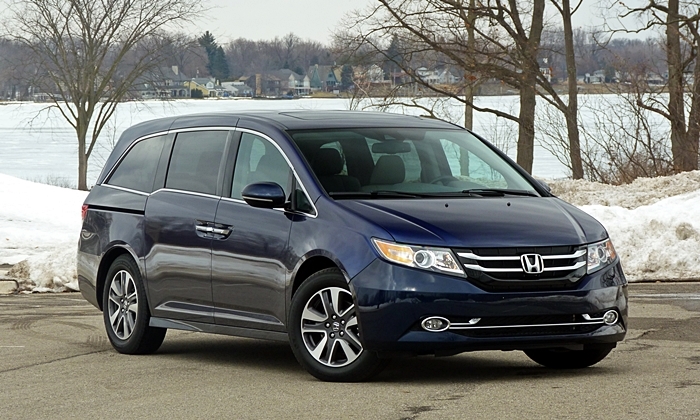
More adventuresome styling than the Toyota. But does anyone really like the zig-zag? more Odyssey photos
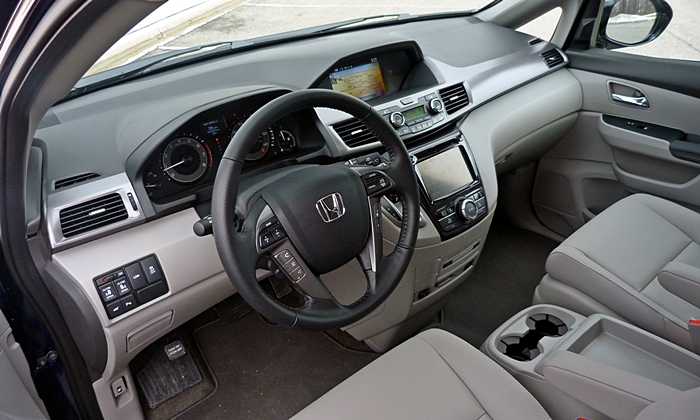
Typical circa-2011 Honda interior doesn't quite measure up to the "Elite" label and $45,000 price.
| |
Compared to the Sienna |
| Rear seat room & comfort |
 Better
Worse
Better
Worse
|
I test a large crossover and think, "This third-row seat isn't bad." Then I drive a minivan and marvel at home much roomier it is inside than even the roomiest crossovers. This advantage increases the farther back in the vehicle you sit. Back in the third row, it's simply no contest.
Among minivans, the Odyssey is the roomiest of the bunch. It's the only minivan with over 40 inches of legroom in each of its three rows. Total up the differences in the official specs, and the Toyota Sienna comes up nearly ten inches short (though the difference doesn't seem nearly so large in reality, maybe an inch or two). A Chrysler Town & Country? Over fourteen inches. A Toyota Highlander crossover has legroom specs similar to the Chrysler minivan, but its third row feels much more cramped. Moral of the story: don't trust the specs, sit in the cars yourself.
In cabin breadth, the official specs have the Odyssey about equal to the Town & Country and a little narrower than the Sienna, but subjectively both the Honda and the Toyota feel broader and more open than the Chrysler.
Then there's access to the rear rows. The feature most associated with minivans, their sliding side doors, are easier to open in tight parking spaces and provide a much larger opening.
In terms of seat comfort, the Odyssey falls a little short of the Sienna, if only because it doesn't offer lounge chair-like legrests in the second row. Then again, for anyone over five feet tall to use these in the Toyota the second row seat must be slid back so far as to render the third row unusable. Either minivan has more comfortable second-row seats than most crossovers, including the Highlander, and third-row comfort is simply no contest. The Chrysler's second row seats aren't as comfortable, as they are more thinly constructed to enable them to fold beneath the floor.
The Odyssey, Sienna, and Highlander can each be equipped to carry eight passengers (though the lounge seats in the Sienna eliminate one spot, and the three in the third row of the Highlander best have short legs). The Chrysler minivans can only seat seven.
| Cargo capacity |
 Better
Worse
Better
Worse
|
Only a few crossovers, the Honda Pilot and a couple from Ford, might have enough space behind their third-row seats for a family's luggage thanks to minivan-like deep wells. And even in these it's a tight fit. Both the Odyssey and the Sienna have about twice as much luggage space behind their third rows as these three-row crossovers, and nearly three times as much as the Highlander (38 vs. 14 cubic feet). A huge difference that, for once, seems at least as large in reality as it does on the specs page.
The Chrysler minivans are the only ones that enable maximum cargo capacity without removing the second-row seats, as these stow beneath the floor (like the third-row seats in all three minivans). In the Honda and Toyota the second-row seat back folds, but it remains far above the floor behind it. For a flat floor (and a total of 149 cubic feet in the Odyssey) the heavy second-row seats must be removed.
For most buyers this isn't a big deal, as they'll rarely need more space than is available behind the second row--a segment-leading 93 cubic feet in the Odyssey (vs. 87 in the Sienna and 42 in the Highlander). Few crossovers offer more cargo space even with their second row seats folded (78 cubic feet in the Highlander). Minivans tend to offer many compartments and cubbies in which to stow small items. Unlike the Chrysler minivans, the Odyssey doesn't have large compartments beneath the floor in the second row. But it does have a large compartment inside a removable first-row console (common in minivans) plus a chilled compartment large enough for four drinks at the base of the center stack.
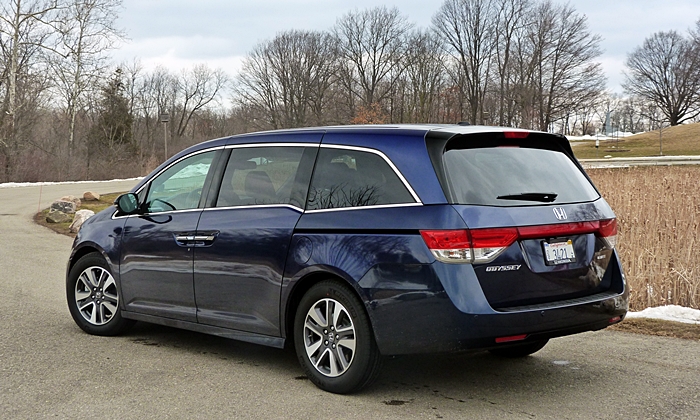
Odyssey styled to appear relatively wide and low from the rear.
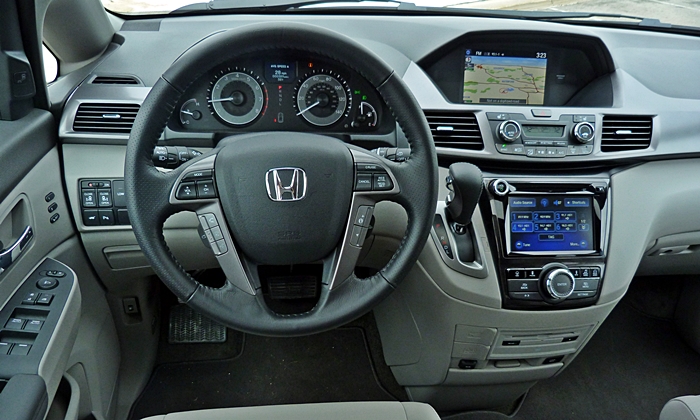
Raked center stack puts HVAC controls beyond reach. Touchscreen not as handy as a tuning knob.
| Safety & braking |
 Better
Worse
Better
Worse
|
In real-world accident stats, minivans are among the safest of all vehicles. This is partly because they're large and lower to the ground than crossovers, partly because (with their large windows) they're easier to see out of than the average vehicle, and partly because of how they're typically driven.
Among minivans, the Odyssey has the best IIHS crash test scores. This is partly because other minivans haven't been subjected to the new small overlap test. The Odyssey scored well in this tough test. But the Odyssey also outscored the Sienna in the government's frontal crash test.
The Odyssey also leads the segment in advanced safety features. A rearview camera is standard in all trim levels, while all leather-upholstered Odysseys add forward collision and lane departure warnings. The former might be available with a fully-optioned Sienna (with the optional adaptive cruise control). The latter isn't available at all. A blind spot warning system is also available, but only (as standard equipment) on the top trim level.
| Fuel economy |
 Better
Worse
Better
Worse
|
"Most fuel-efficient minivan" might seem like faint praise, but the Honda Odyssey does hold this title. For such a large vehicle EPA ratings of 19 mpg city, 28 mpg highway are fairly impressive. The Toyota checks in with 18/25, the Chrysler with 17/25.
| Reliability & durability |
 Better
Worse
Better
Worse
|
Both the Honda Odyssey and Toyota Sienna have been reliable recently, aside from the 2011 models (the first year of the current design in both cases). As minivans age, the power sliding doors tend to be a common problem area.
A few years ago, 1999-2003 Odysseys suffered from unusually common transmission failures, but the four-speed automatic transmission in question is no longer offered. Instead, for 2014 a six-speed automatic is standard on all trim levels.
| |
Compared to the Sienna |
| Exterior styling |
 Better
Worse
Better
Worse
|
The #1 reason people don't buy minivans is their exterior styling. They just don't look rugged and adventurous the way crossovers do. Some attempts were made to style minivans like SUVs. But these fooled no one, and failed.
With the 2011 Odyssey, Honda tried something a little different, and zig-zagged the bottom edge of the side windows. Though this does provide passengers in the third row with a more open view, and I personally find the result aesthetically interesting, most people dislike the Odyssey's exterior appearance. From same angles it looks like the vehicle got crunched in an accident. The Sienna has sleeker, cleaner, more conventional styling. The Chrysler minivans, on the other hand, are homely boxes.
| Feature availability |
 Better
Worse
Better
Worse
|
As noted earlier, the Odyssey does offer more safety features than competitors, including the Sienna.
But many people buy crossovers for the additional traction of all-wheel-drive, and among minivans only the Sienna offers this option.
The Sienna also offers those trick louge chairs, a second, fully functional sunroof over the second row, and adaptive cruise control.
For 2014, the Odyssey has become the only vehicle to offer a built-in vacuum cleaner, as standard in the top trim level. As it happens, I'd spilled a little sugar in the back of the Toyota Highlander that was being picked up as the Odyssey was being dropped off. The Hondavac sucked up most but not nearly all of the spilled sugar. It likely works better with fluffier debris, such as dust and small bits of paper. Some sort of brush attachment would help.
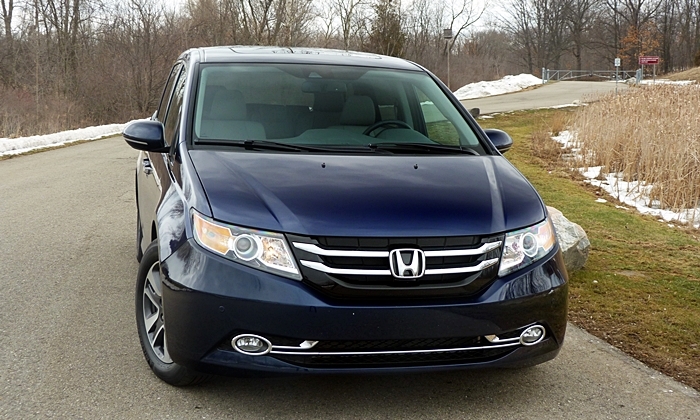
Cleaner face than the 2011-2013 Odyssey.
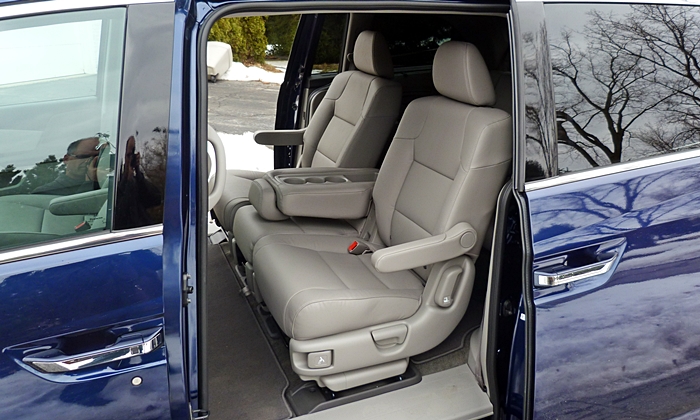
Center section folds to form an armrest with cupholders.
| Controls and instruments |
 Better
Worse
Better
Worse
|
The Odyssey's HVAC controls are a too far away (while the Highlander's are even more of a reach, and some of the Sienna's are too far to the right). The touchscreen-based nav and audio controls are difficult to figure out and navigate. The Sienna Limited retains the last generation head unit, without app support but with a separate tuning knob. Lesser trim levels have the new Entune system, with app support but without a separate tuning knob. The Chrysler, with easier to reach controls and a more intuitive interface, wins this area.
| Quietness |
 Better
Worse
Better
Worse
|
Road noise is a perennial Honda weakness. While the latest Odyssey is quieter than earlier ones, the Sienna is quieter still. Some crossovers, including the Highlander, are significantly quieter than either. It's hard to keep road noise out of a big box with a low floor.
| Price or payments |
 Better
Worse
Better
Worse
|
The tested top-of-the-line Honda Odyssey Touring Elite lists for $45,280. A Toyota Sienna Limited with Premium and Convenience Packages lists for even more, $46,425, but also includes about $1,400 in additional features. So fully equipped the two vans are very close in price. A loaded Chrysler Town & Country Limited checks in a little lower, $44,605, while including about $1,200 in additional features. Incentives will likely further increase the Chrysler's price advantage. A Toyota Highlander Limited with rear seat entertainment system lists for significantly less than the Odyssey, $42,664, but also includes fewer features. Adjust for these, and the difference is about $1,100, not large.
These comparisons all involved loaded vehicles. The Odyssey's pricing problem, to the extent that it has one, occurs at the other end of the range. The least expensive Odyssey still lists for nearly $30,000, $29,655 to be precise. The Sienna starts just over $28,000. Feature differences account for about $1,000 of the price difference, so they're not too far apart in content-per-dollar terms.
But the least expensive Dodge Grand Caravan (the AVP, for "American Value Package") lists for only $20,990, while the more popular Grand Caravan SE lists for $24,390. If you can live with a lightly contented minivan, the Dodge undercuts the Honda by $8,665 before adjusting for feature differences, and about $6,600 afterwards. The gulf isn't quite as wide with the SE, which is equipped at about the same level as the base Odyssey, but is still about $5,000. As noted earlier, dealer discounts and factory incentives could further increase the Dodge's price advantage. Among modestly equipped minivans, it's the clear price leader.
| |
Compared to the Sienna |
| Materials & workmanship |
 Better
Worse
Better
Worse
|
All of the leading minivans have hard plastic instrument panels, and tend to trail similarly priced crossovers in the luxuriousness of their materials. The Sienna attempts a more luxurious ambiance with fake wood trim, but the faux timber is undermined by the oddly grained plastic that surrounds it. Subjective preferences between the two will vary. The Chrysler feels dated inside. No doubt all three minivans will receive dramatically upgraded interiors when they are redesigned for the 2017 model year.
| Powertrain performance |
 Better
Worse
Better
Worse
|
The Honda Odyssey has the weakest V6 engine in the segment, 248 horsepower compared to 266 in the Toyota and 283 in the Chrysler, and it doesn't accelerate with quite as much gusto. But it's plenty quick for how minivans tend to be driven.
| Handling |
 Better
Worse
Better
Worse
|
Both the Odyssey and Sienna have light steering and car-like but not sporty handling. The Town & Country, with firmer steering and a more tightly damped suspension, handles the best of the three. When I tested a Dodge Grand Caravan a few years ago, I was surprised how much I enjoyed driving it.
| Ride smoothness |
 Better
Worse
Better
Worse
|
The Sienna has the plushest ride. The Town & Country's suspension best controls body motions. Even over bad pavement you'll experience little pitching fore-and-aft or tossing from side-to-side. The Odyssey has a busier ride than either, but not to the extent that many people will find it objectionable.
Crossovers simply don't come close to minivans in passenger and cargo space. Among the three segment leaders, the Chrysler minivans are the most enjoyable to drive, and can hold the most cargo without removing any seats. The Toyota Sienna offers the most high-end features, including some nifty second-row lounge chairs, and has the smoothest, quietest ride. But the Honda Odyssey scores wins in categories that tend to matter most to minivan buyers, including interior space, safety, and fuel economy, while roughly matching the Sienna for best reliability. Unless the 2015 Kia Sedona manages to outdo the Honda in these areas, the Odyssey will remain the top choice for most minivan buyers. (Just don't expect much from the vacuum in the Touring Elite.)
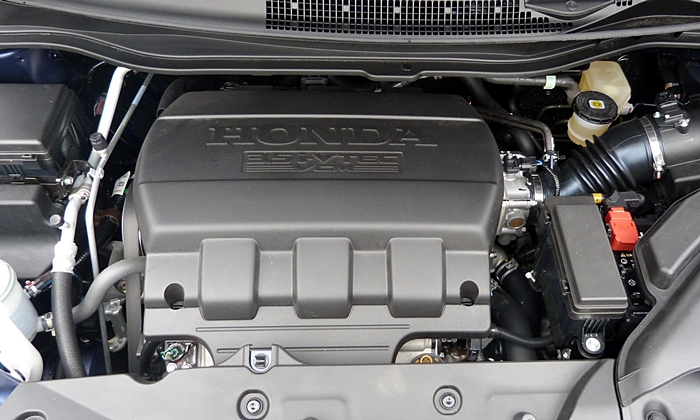
Honda Odyssey 3.5-liter V6 isn't as strong as competitors' engine, but is more fuel efficient.
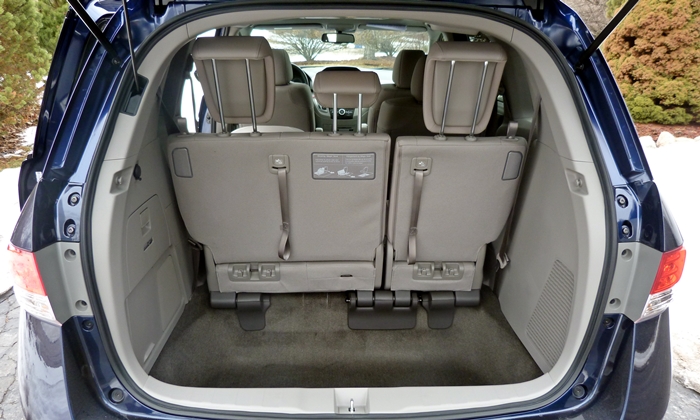
Minivan money shot: two to three times as much cargo space behind the third row as in a crossover.
See more 2014 Honda Odyssey photos
Honda provided an insured Odyssey for a week with a tank of gas. Toyota did the same with a Highlander. Chris Yee of Page Toyota in Southfield, MI, provided a Sienna for comparison. Chris can be reached at 248-352-8580.











